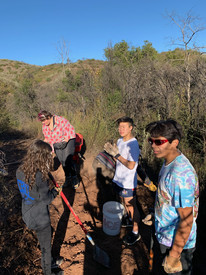Youth Climate Challengers Finish Strong in 2020
- Climate Kids HQ
- Sep 25, 2020
- 4 min read
Earlier this year, our 2019-2020 Youth Climate Challenge participants wrapped up their projects addressing local climate issues. Check out the incredible things they accomplished in just six short months!

The Youth Climate Challenge is an immersive experience that connects students with leading climate scientists, practitioners, artists, and fellow youth. In challenge teams, students are guided and challenged to identify and analyze the climate impacts in their own communities. Together, they investigate climate strategies and solutions and formulate action plans to implement in their sphere of influence.
Earlier this year, our 2019-2020 Youth Climate Challenge participants wrapped up their community-based projects addressing local climate issues. Check out some of the amazing things they accomplished in just six short months!
2019-2020 Youth Climate Challenge Accomplishments

Registered and officially recognized as a student-run organization at The University of Arizona campus on September 27, 2019.
Partnered with the Native American Student Association (NASA) cultural center, American Indian Science Engineering Society (AISES), GRID Tribal Alternatives, South West Environmental Health Sciences Center (SWEHSC), Students for Sustainability (SFS) club, and Baboquivari High School.
Helped install a solar panel system to a family living without electricity with GRID Tribal Alternatives on the Navajo reservation.
Organized an Environmental Justice panel discussion with other environmental organizations on campus and provided environmental outreach services (sustainable rainwater harvesting project and recycling program) to the Baboquivari High School.

Worked to better understand the physiological and morphological characteristics of their study species, Ecklonia arborea, by working with researchers in the intertidal zone of Todos Santos Bay, Ensenada.
Developed and implemented aquaculture experiments for the evaluation of absorption of Ammonium and Urea in E.arborea. Experiments are ongoing.
Partnered with MexCal, a scientific research group that has cooperation with fishing groups in Baja California and has projects to develop trophic aquaculture. This will allow students to have a connection with the fishing community and help inform this community with their research.

Helped recruit participants for the Ventura Coastal Cleanup Day, put up an information board, and supplied a cleanup in Libbey Park. Libbey Park is a central area in Ojai, and a major landmark to its residents. As well as being a well-known community landmark, it contains a tributary to the Ventura River. Over 70 volunteers showed up to the event, and they picked up hundreds of pounds of trash. There was seventy-five pounds of just tennis balls alone! Overall, the cleanup was a major success, and it opened up many opportunities for the students.
Hosted a booth at the Telluride Mountain film On Tour. There, VYWSC had posters and presentation boards set up near the center of the event. Over 2,000 people showed up to the event, and students were able to talk to many people who were interested in volunteering. An estimated 300 people viewed the VYWSC poster.
Partnered with the Ojai Valley Land Conservancy and the Ojai Valley Green Schools Coalition. VYWSC helped with the construction of a bridge to protect a spring on a tributary of the Ventura River. Mountain bikers, hikers and equestrians enter the streambed to cross to the other side as they make their way along the trail; the bridge will protect important habitat and will be better for the recreational community.
Joined with REI and the Santa Barbara Botanical Gardens to participate in a citizen science recovery project aimed at mapping the recovery of the Thomas Fire.
Hosted a 2020 World Wetlands Day Festival for the community of San Quintín
Photographic Safari in Wetlands: 120 middle and high school students (from Telesecundaria 59 and Cobach San Quintín, respectively) were given a guided visit to the San Quintín Bay wetlands, where they learned about the environmental value of San Quintin Bay and the importance of wetlands to mitigate climate change. They also had the opportunity to take pictures and explore the surroundings. They were surprised and delighted to receive this talk by young people of their same age.
Environmental Education Activities: The Club members presented three educational modules to the 120 students with the support of their teacher, as well as archeologist Enah Fonseca and Terra Peninsular staff members. The educational modules they presented were: 7 “Leave No Trace” principles, “The Natural World of San Quintín”, and “Discovering The Past, San Quintín Archaeology”.
Developed an informative brochure in English and Spanish. The Club participated with 12 photos of their authorship in the exhibition “Travesía, a look at the natural world of San Quintín.”
Managed a workshop on social network and strategic communication management, but the club's social networks have not yet been made to the public. Thanks to the diffusion of the 2020 call, as well as the wetlands event and exhibition, the club received the interest from young people and adults to join the club. To date, 8 new members have joined the club. The club has also received many requests from the Caracol Science Museum and the Autonomous University of Baja California to make exhibitions of the Club’s work.
Presented an exhibition at the San Quintín City Hall, where students talked about the origin of “Huellas Volcánicas” and presented the 8 new members. This first exhibition was on display for one month; more than 1,000 residents of San Quintín have visited it and learned about the club and the projects that they are currently carrying out.
The Club was publicly recognized by key government and tourism actors in San Quintín.
Good job Youth Climate Challengers - we are so proud of all that you have accomplished!
To learn more about the Youth Climate Challenge, please visit:














Comments